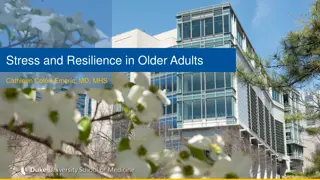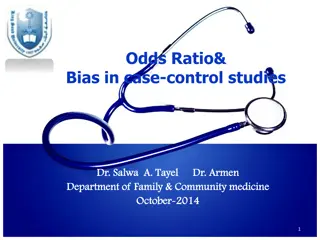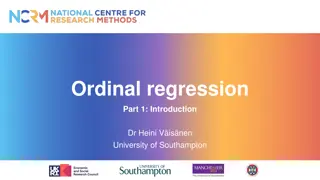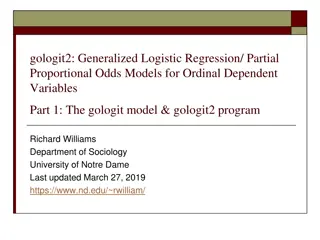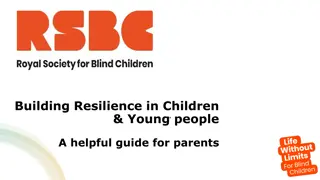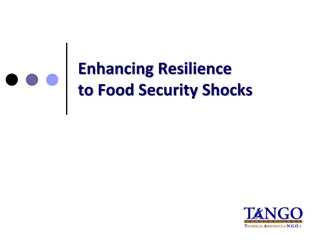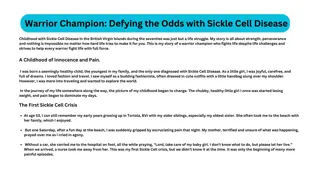Understanding Resilience in Young People: Defying the Odds
Resilience in young individuals involves achieving positive outcomes despite facing adversity, such as overcoming risks and challenges, and adapting successfully to difficult circumstances. Research by Ingrid Schoon explores the factors contributing to resilience and successful youth transitions, emphasizing the importance of protective factors, societal contexts, and individual adaptations.
Download Presentation

Please find below an Image/Link to download the presentation.
The content on the website is provided AS IS for your information and personal use only. It may not be sold, licensed, or shared on other websites without obtaining consent from the author. Download presentation by click this link. If you encounter any issues during the download, it is possible that the publisher has removed the file from their server.
E N D
Presentation Transcript
Why do some young Why do some young people defy the people defy the odds? odds? Ingrid Schoon UCL, Institute of Education Social Science Center Berlin (WZB) DfE Education Research Symposium School to work transitions in a changing labour market: Implications for schools and colleges 3 February 2017
Outline Outline Making it against the odds the study of resilience Risk and resilience What is a successful youth transition? Protective factors and processes
What is Resilience? What is Resilience? positive outcomes despite the experience of adversity continued positive or effective functioning in adverse circumstances recovery after a significant trauma Rutter, 1987, 2012; Masten, 2001, 2014; Schoon, 2006, 2012, 2017
Identifying resilience Identifying resilience Resilience is not a personality characteristic It is not directly measured, but based on two judgements: is there now or has their been any significant risk or adversity to be overcome? is the person doing ok?
A Developmental-Contextual Model of Resilience Socio-historical context Institutions Neighbourhoods Family Adaptation Individual Adaptation AdaptationAdaptation Risk Risk Risk Risk Birth Adulthood Schoon, 2006
The Concept of Risk The Concept of Risk Statistical versus actual risk Focus on single risk factors Parental psychopathology Family instability Poverty Accumulation of risk effects -> multiple risk models Plurality of meaning Duration and timing of risk effects Domain specific effects The context of risk Schoon, 2006, 2012, 2017
Positive Adaptation Positive Adaptation Doing ok (Mastern, 2001, 2014) Adjustment within the average for a normative cohort Meeting developmental tasks focus on multiple interlinked dimensions, e.g. physical, cognitive, social, emotional, self- determination
The Transition to Adulthood The Transition to Adulthood Pivotal in setting the scene for adult functioning and adjustment; is both formative and risk laden Demographically dense period involving assumption of multiple, interlinked social roles: The Big 5 Shaped by previous experiences and current conditions
Youth Transitions in a Changing Social Context Youth Transitions in a Changing Social Context Evidence from UK Cohort and Panel Data Evidence from UK Cohort and Panel Data LSYPE (n=15,884) Annual survey since 2004 age 14-20 BHPS (Panel Study; started in 1991) Since 1994 youth panel of 12-15 year olds is included 1970 British Cohort Study (BCS70); n=17,189 Age 5 10 16 26 30 34 38 42 46 1974 1980 1986 1991 1996 2000 2004 2008 2012 2016 Oil crisis Onset of the recession Second wave Recovery Credit Crunch Collapse of housing market New Technologies IT and social media Brexit Trump Post- truth Globalization
Indicators of social risk in two age cohorts growing up twenty years apart Dichotomised indicators of social risk that are comparable across the two cohorts BCS (%) Born 1970 Aged 16 in 1986 LSYPE (%) Born 1990 Aged 16 in 2006 Low parent education (<NVQ2) .49 .16 Low parent SES (routine occupations) .18 .23 YP lives in a lone parent household .03 .17 YP was born to a teen parent .08 .07 YP lives in social housing .28 .12 YP lives in a workless household .04 .09 Duckworth & Schoon (2012)
Cummulation of risks Given comparability in the two datasets, we combine indicators into a single score of the summed dichotomous indicators 60 50 40 30 BCS 20 LSYPE 10 0 0 1 2 3 4+ 2.8 8.1 BCS LSYPE 38.1 52.5 28.8 21.7 21.1 11 9.4 6.8
The youth labour market in historical context Comparing experiences in two age cohorts BCS: born 1970, aged 18 in 1988 LSYPE: born 1990, Aged 18 in 2008 FT education 25% 45% Employed (with or without training) 68% 40% (33% paid work, 6% apprenticeships) Out of the labour force (NEET) 7% 16%
Greater experience of social risks is associated with becoming NEET The greater the number of social risks experienced by young people, the higher their likelihood of becoming NEET This relationship is remarkably linear and is particularly marked for young people in the later born LSYPE Persistent NEET between 16-18 8 Likelihood of being NEET 6 4 BCS 2 LSYPE 0 1 2 3 4+ Number of Risks Duckworth & Schoon (2012)
Beating the Odds: Risk and Resilience NEET Yes No Expected Vulnerability Resilient: doing well in the face of adversity Low High Risk Unexpected vulnerability Expected positive adjustment
Protective Factors: The Short List Protective Factors: The Short List Family and Social Networks Effective care-giving and parenting Close relationships with other capable adults Close friends and romantic partners Wider community Effective schools Effective neighbourhoods Individual characteristics Problem-solving skills Self-control, emotion regulation, planfulness Motivation to succeed Self efficacy Masten, 2001, 2014; Schoon, 2006, 2012, 2017
Risk and Protection Reference group is the Expected group, i.e. YPs exposed to risks who become NEET Not NEET for 6 months or more between ages 16 19 years BCS LSYPE .89 .69*** 1.21* 1.05 1.69** .72*** 1.07 1.19 1.26** 1.51** Cumulative Social Risk score Female Reading (age 10/11) Maths (age 10/11) School motivation (age 16) 1.13 1.44*** YP wants to stay on in education (age 16) 1.93*** 1.66*** YP does not truant (age 16) 1.95*** 1.24 YP has part-time job (age 16) 1.09 1.23 Parent wants YP to stay on (age 16) 1.18*** 1.20** School characteristics (social indicators ) p <.10; * p <.05; ** p <.01; *** p <.001 Duckworth & Schoon, 2012
Other significant influences Ability concepts Achievement orientations Optimistic outlook to the future Locus of control Experience of career guidance Area characteristics (Schoon, 2014, 2017; Schoon & Lyons-Amos, 2016, 2017)
Locus of control as resource factor Parental worklessness Parent working Locus of Control (LOC) Is someone is not a success in life, it is usually their own fault I can pretty much decide what will happen in my life If you work hard at something you ll usually succeed 16 14 12 NEET (months) 10 8 6 Parental worklessness (>6months unemployed) measured at wave 1 4 2 0 LOC low LOC medium Axis Title LOC high Ng-Knight and Schoon, submitted
Why to some young people defy the odds? Constellations of risk matter otiming, duration and accumulation Individual agency oPlanfulness, competence, Social integration o Belonging, support, guidance Available opportunities oArea characteristics, jobs, prospects self-regulation Maslow, 1943
Implications for Schools and Colleges Fostering autonomy, competence and sense of belonging Recognise the multiple demands on adolescents and young people Reach out to the most vulnerable, building trust and acceptance Provide opportunities to experience competence and gain confidence this involves appropriate academic emphasis, reflection, clear rules, high expectations, and fairness Teach how to cope with failure and rejection in a positive way Facilitate a sense of belonging and integration crucial role of social experience Provide information and guidance Invest in high quality and well-trained staff Liaise with parents, the wider community and employers to create sustainable support structures
Implications for Policy Need to meet the needs of families struggling with multiple disadvantages Support for basic needs (food, shelter, security, infrastructure, living wage) Holistic approach community-based partnership among different service agencies and integrated service delivery Sustainability of programmes Opportunities for development and social participation (e.g. through work, volunteering, life long learning)
Thank you I.Schoon@ucl.ac.uk
Selected References Duckworth, K., & Schoon, I. (2012). Beating the odds: Exploring the aspects of social risk on young people's school-to-work transitions during recession in the UK. National Institute Economic Review, 222, 38-51. Schoon, I. (2006). Risk and Resilience: Adaptations to changing times. Cambridge: Cambridge University Press Schoon, I. (2014). Parental worklessness and the experience of NEET among their offspring. Evidence from the Longitudinal Study of Young People in England (LSYPE). Longitudinal and Life Course Studies, 6(1), 129-150 Schoon, I. (2012). Temporal and contextual dimensions to individual positive development: A developmental-contextual systems model of resilience. In: M.Ungar (Ed). The social ecology of resilience: culture, context, resources, and meaning. New York: Springer (pp.143-156) Schoon, I. (2017). Making it against the odds: diverse strategies and successful adaptation. In A. C. Peterson, S. H. Koller, F. Motti-Stefanidi, & S. Verma (Eds.), Positive youth development in global contexts of social and economic change. New York: Routledge. Schoon, I. & Lyons-Amos, M. (2017) A socio-ecological model of agency. Longitudinal and Life Course Studies, 8 (1), 35-56






